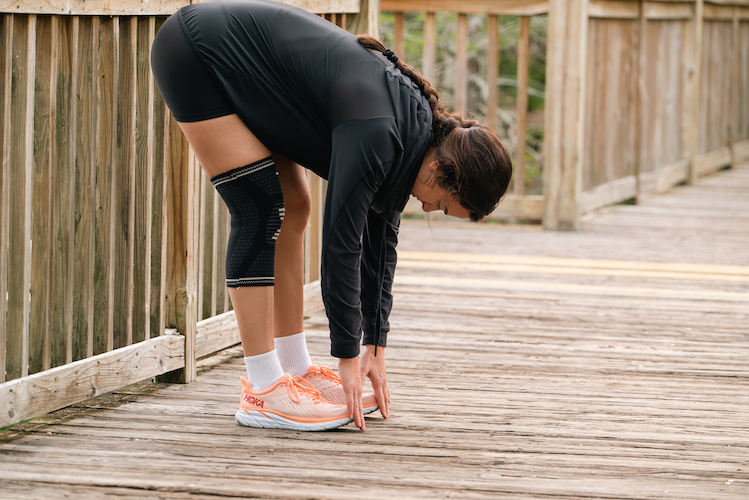
Your Guide to Soothing Knee Swelling (5 Knee'd-to-Know Things)
- Disclaimer: This article is not a substitute for professional medical advice. Always consult with a healthcare provider for accurate information.
Ever woken up to a knee that's swollen and throbbing, leaving you wondering what you did to deserve this?
Whether it's from that epic hike last weekend, your daily jog, or just an unfortunate encounter with a coffee table, knee swelling is a real pain. But don't worry, we've got you covered.
Here's your ultimate guide to understanding, managing, and preventing knee swelling.
What's the Deal with Swelling?
Swelling is your body's not-so-subtle way of saying, "Hey, something's not right here!" It's a sign of inflammation, a buildup of fluid around a damaged area, making it larger and puffier.
In the knee, this can be due to effusion (swelling inside the joint), edema (swelling in tissues around the joint), or hemarthrosis (swelling and a buildup of blood within the joint).
Related: What is a Knee Compression Sleeve? (5 Things to Know)The Usual Suspects
Bursitis
Bursitis is when the fluid-filled sacs in your knee, called the bursae, get irritated. This can be due to frequent kneeling or blunt force trauma to the knee.
Arthritis
Arthritis is another common cause of knee swelling. It's like your knee's way of saying, "I'm getting old, and I don't like it!" Several types of arthritis can cause knee swelling, including osteoarthritis, rheumatoid arthritis, and gout.
Acute Injuries
Acute injuries can result from sports, exercise, or accidents involving blunt force trauma to the knee.
Infections
Infections such as lupus or Lyme disease can also cause swelling in the knee.

Home Remedies: Your First Line of Defense
Before you rush to the ER, there are a few things you can do at home to reduce knee swelling:Rest: Give your knee a break. It's earned it.
Ice and Elevation: Apply ice to your knee for 15 to 20 minutes every 2 to 4 hours for the first two to three days. Remember to elevate your leg to reduce blood flow and inflammation. It's like giving your knee a mini vacation.
Compression: Wrap an elastic bandage around your knee or wear a knee compression sleeve to prevent fluid from accumulating. But don't wrap it too tight; you don't want to cut off circulation. It's like giving your knee a comforting hug.
Pain Relievers: Over-the-counter medications like acetaminophen (Tylenol) and ibuprofen (Advil, Motrin) can help with knee pain. It's like sending in the cavalry to fight the pain.
Recommended: TKWC Knee Compression Sleeve
When to Dial Your Doc?
While home remedies are a great starting point, it's essential to know when it's time to call in the pros.
Here are some signs that it's time to pick up the phone and make an appointment:- Severe Swelling or Pain: Should your knee significantly swell, resembling a grapefruit, or the pain cause you to wince, contact your doctor.
- Limited Mobility: If your knee's movement resembles a rusty hinge, inhibiting your ability to fully straighten or bend it, it's advisable to seek medical assistance.
- No Improvement with Home Remedies: If the swelling in your knee persists after three days despite rest, ice, compression, and elevation (the RICE method), a professional consultation is warranted.
- Fever: A body temperature of 100.4°F or higher necessitates immediate contact with a healthcare professional, as it could indicate an infection.
- Red and Warm Knee: If your knee appears red, akin to a ripe tomato, and feels warm to the touch, it's imperative to seek medical help immediately. This could be indicative of an infection within the joint.
- Instability: If your knee gives a sensation of instability or inability to bear weight, a visit to the doctor is necessary. This could signal a torn ligament.
- Sharp Pain When Rising from a Squat: Experiencing sharp pain while rising from a squatting position requires medical attention, as this could indicate a torn meniscus.
Remember, it's always better to be safe than sorry when it comes to your health. If in doubt, reach out to a healthcare professional.
Prevention is Better Than Cure
To avoid future knee swelling, consider the following:- Strengthen the Muscles Surrounding Your Knee: Enhancing muscular strength can alleviate stress on the knee joint.
- Opt for Low-Impact Exercises: Engage in activities such as water aerobics and swimming that minimize continuous weight-bearing stress on your knees.
- Preserve a Healthy Weight: Maintaining an optimal weight can prevent undue wear and tear that could result in knee swelling.
Closing thoughts
Knee swelling is a bummer, but with the right knowledge and care, it doesn't have to slow you down. Remember, your body is your most valuable asset, so take care of it.
Now, go forth and conquer the world (but maybe watch out for those coffee tables).
More Great Rent A Knee Walker News & Stories
- •
- •
- •
- •
- •

